When it comes to timeless menswear staples, few pieces rival the versatility and sophistication of the blue suit. Whether you’re dressing for a wedding, a business meeting, or a stylish night out, the blue suit is a modern essential that effortlessly bridges classic tailoring with contemporary flair. But there’s one question that any gents who try to make their blue suit look good might ask atleast once: What color tie to wear with a blue suit? In this guide, we’ll explore the best tie colors pairing and show you how to choose a combination that suits the occasion, complements your shirt and reflects your inner self.
1. Factors to consider when choosing a tie color to wear with blue suit
Before you reach for the first tie in your drawer, it’s important to consider a few key elements that will influence how well your tie pairs with your blue suit, which each detail plays a vital role in creating a polished and intentional look.
Shade of the blue suit
Not all blue suits are created equal. A deep navy suit, for instance, pairs effortlessly with bolder, richer tie colors like burgundy, forest green, or gold. It’s a classic canvas that welcomes contrast. A royal blue suit, on the other hand, has a more vibrant tone and works beautifully with complementary shades like deep purple, grey, or patterned ties.
For lighter hues such as sky blue or powder blue, softer tones like blush pink, light grey, or a floral print tie can add charm and elegance without overwhelming the look. Understanding the shade of your suit is the first step to creating harmony in your outfit.
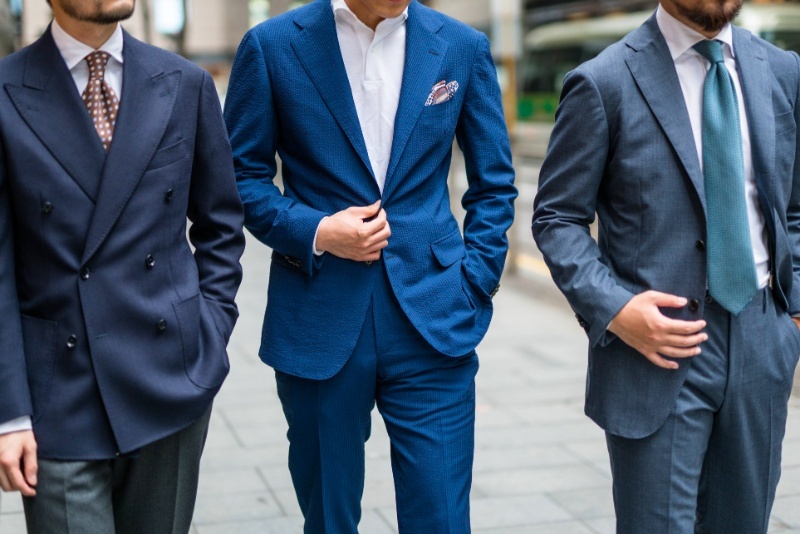
Shirt color and fabric texture
Your shirt acts as the bridge between your suit and your tie, so the color and texture should never be overlooked. A crisp white shirt is the most versatile, allowing almost any tie color to shine. Light blue shirts pair well with darker or contrasting ties, while patterned shirts require more thought. Simpler ties often work best to avoid clashing.
Additionally, consider texture: a matte cotton shirt pairs well with silk ties, while a shirt with a subtle weave or soft fabric might benefit from a wool or knitted tie for seasonal flair and depth.

Occasion and dress code
The event or setting you’re dressing for can greatly influence your tie color choice. For formal events or corporate meetings, darker and more subdued tones like navy, burgundy, or silver are safe bets. Weddings and social events allow for more personality—think floral ties, bold patterns, or pops of pastel. For casual or smart-casual settings, don’t be afraid to experiment with textured fabrics like knits or linen ties in playful colors. Matching the mood and formality of the occasion ensures your outfit feels intentional and appropriate.

Personal style and skin tone
Finally, your personal taste and natural coloring can guide your decision. If you prefer a classic, understated look, monochromatic combinations or neutral tones may be your go-to. If you enjoy standing out, vibrant ties with a bit of pattern or sheen can make a stylish statement. Also, think about your skin tone. Cool-toned individuals often look best in blues, greys and jewel tones, while warmer complexions tend to suit earthy shades like olive, rust or gold.

2. Best tie colors to wear with a blue suit
Navy tie
Pairing a navy tie with a blue suit is a timeless move. It looks simple at first glance, yet remarkably sophisticated when done right. This tone-on-tone approach is beloved for its elegance and understated charm. Rather than drawing attention with contrast, it lets the clean lines and fit of your suit take center stage. It’s a look that speaks quietly, but with confidence.
A navy tie is especially fitting for formal or business environments where professionalism and subtlety are key. Whether you’re attending a corporate meeting, giving a presentation, or dressing for a formal dinner, this pairing sends the right message: polished, composed, and reliable. A white dress shirt creates a crisp foundation that enhances the depth of the navy-on-blue combination, while a pale blue shirt can add a more relaxed, tonal effect.
To avoid the look becoming too flat or predictable, play with textures and accessories. Consider a navy silk tie with a light sheen for a touch of sophistication, or opt for a knitted or wool tie to add visual interest and seasonal character. You can also introduce a pocket square in a complementary shade like light grey, silver or patterned blue, to break up the monochrome and create a refined point of contrast.

Burgundy or Wine tie
A burgundy or wine-colored tie brings depth, personality and unmistakable confidence to any blue suit. Unlike the more reserved navy tie, burgundy introduces warmth and richness, making it a standout choice for those who want to express strength without being overly bold. It’s a color long associated with luxury, maturity, and quiet authority—ideal for professionals who want to look both sophisticated and self-assured.
Burgundy ties work exceptionally well with darker shades like navy, where the contrast adds visual interest while still maintaining a cohesive palette. With a royal blue suit, the deep red tones of a wine tie create a striking yet harmonious effect that draws the eye in all the right ways. Pair it with a crisp white shirt for a sharp, high-contrast look, or soften the combination with a pale pink or light grey shirt for added nuance.
This combination is particularly fitting for high-stakes settings such as important meetings, formal evening events, or semi-formal occasions where you want to leave a lasting impression. The burgundy tie says you’re serious, yet stylish—someone who understands classic rules but isn’t afraid to inject personality into their appearance.
To elevate the look even further, consider a silk burgundy tie with subtle texture or a matte finish, and complement the outfit with a patterned pocket square that echoes similar warm tones.

Grey or Silver tie
A grey or silver tie is the epitome of understated elegance when worn with a blue suit. These neutral tones offer a refined contrast that enhances the coolness of blue without overpowering it. The result is a look that’s modern, graceful, and exceptionally versatile. A good choice for both daytime sophistication and evening elegance.
Grey ties, especially in mid-tones or charcoal, lend a grounded, balanced feel that works beautifully in business settings. When paired with a navy or royal blue suit, a grey tie creates a sleek, polished appearance that feels confident but never loud. It’s a subtle nod to professionalism that doesn’t rely on bold color to make an impression.
Silver ties, on the other hand, introduce a touch of formality and shine. Their light-reflective quality makes them especially suitable for special occasions like weddings, galas, or evening events. A silver tie with a bit of sheen or woven texture adds depth and dimension to your outfit, making it feel more celebratory without veering into flashy territory.
For the shirt, white is a flawless choice that brightens the face and complements the crispness of the silver or grey. Light blue shirts also pair well, adding tonal depth while keeping the palette cool and coordinated. To finish the look, consider a pocket square in soft grey, navy, or even a subtle metallic pattern that echoes the sophistication of the tie.

Black tie
A black tie with a blue suit is the embodiment of classic formality. This combination is ideal for occasions where a high level of sophistication is required, such as black-tie galas, formal weddings, or high-level corporate events. The black tie provides an undeniable sense of authority and timelessness, creating a look that’s both sleek and sharp, especially when paired with a deep navy suit.
While pairing black with blue is undeniably stylish, it’s important to recognize when it’s appropriate. A black tie is best reserved for the most formal events—think evening galas, upscale dinner parties, and interviews in the highest levels of business. It’s not typically suitable for casual or semi-formal occasions, as it can appear too severe or rigid for less structured environments.
To avoid the look becoming too stiff or monotonous, consider adding a subtle touch of texture or sheen. A satin finish on a black tie creates an elegant contrast against the matte fabric of your suit, adding an extra layer of sophistication. Alternatively, choosing a black tie with a subtle embossed pattern or texture, such as a jacquard weave, can introduce visual interest while maintaining the formal tone. These small details ensure your outfit remains stylish yet not overly rigid, striking the perfect balance between formal and fashionable.
To complete the ensemble, pair the black tie with a crisp white shirt for a traditional and sharp appearance, or opt for a light grey shirt for a softer contrast. A simple pocket square in white or navy will provide the finishing touch, offering balance without competing with the formality of the black tie.

Red Tie
A red tie is undeniably one of the most powerful and commanding choices you can make when pairing it with a blue suit. Known for its association with power, confidence, and determination, red instantly draws attention and communicates authority. Whether you’re heading into an important business meeting, a leadership role event, or a presentation, a red tie is your go-to for making a strong impact.
Pairing a red tie with a navy or royal blue suit creates a striking contrast, making it ideal for settings where you want to convey both professionalism and decisiveness. The boldness of red against the cool tones of blue signals confidence and leadership, making it an excellent choice for corporate environments, interviews, and high-stakes situations. A crisp white shirt complements this combination, providing a clean and sharp look that ensures the red tie doesn’t overpower the rest of the outfit.
However, it’s important to be mindful of the context in which you choose to wear a red tie. While it works beautifully for formal, business, or authoritative settings, it may not be the best fit for more laid-back, casual events or relaxed social gatherings. A red tie can feel out of place in a cozy, intimate setting or at a casual event where a softer, more understated look is preferred. In those cases, opting for a more subtle color or a patterned tie may be a better choice.
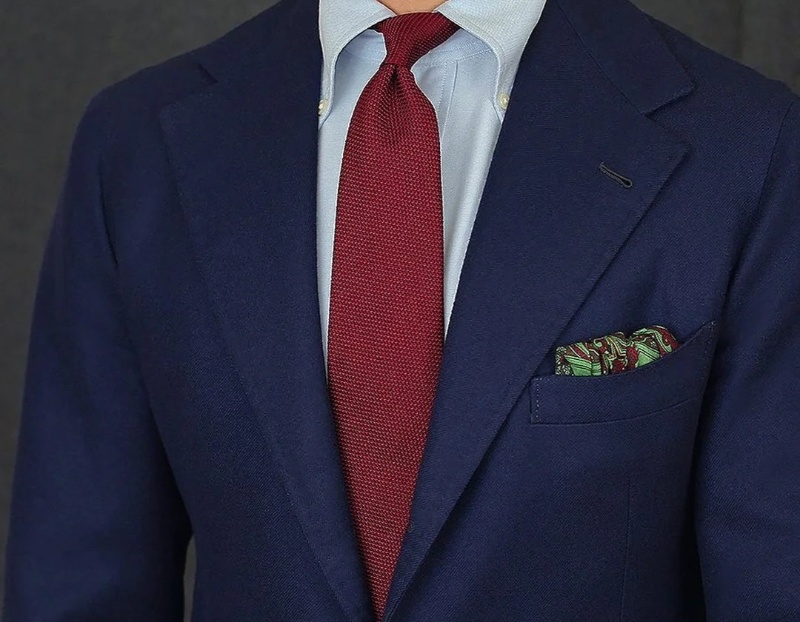
Green tie
A green tie, particularly in deep shades like forest green, offers a refreshing and sophisticated contrast when paired with a blue suit. Though not as commonly seen as other tie colors, a green tie stands out with its unique blend of earthiness and modern flair. It’s an excellent choice for those looking to make a distinctive impression without straying too far from traditional styles.
The beauty of a green tie lies in its ability to pair seamlessly with blue suits, especially navy or deep blue, while still providing enough contrast to capture attention. When combined with a white shirt, this pairing strikes a perfect balance—polished yet youthful. The cool tones of both colors work in harmony, creating a look that is both mature and contemporary. It’s the ideal combination for those who want to project professionalism while still showcasing a modern sense of style.
A green tie is especially well-suited for creative meetings, fashion events, or workplaces that embrace modern, stylish dressing codes. Its unique appeal makes it an excellent option for environments that value innovation and forward-thinking. Whether you’re attending a fashion-forward gathering or aiming to stand out in a dynamic corporate setting, a green tie with a blue suit offers a confident, modern edge without sacrificing sophistication.

Pink or Pastel Tie
A pink or pastel tie adds a touch of lightness and approachability to any blue suit, making it a perfect choice for those looking to project a friendly, youthful, and approachable image. These soft hues exude a sense of warmth and charm without overpowering the overall outfit, making them ideal for spring or summer events, daytime weddings, or semi-formal occasions.
Pink ties, particularly in muted shades like dusty rose, blush, or smoky pink, offer a subtle sophistication without feeling overly feminine. These tones maintain the balance between modern flair and classic appeal, ensuring the outfit remains stylish while exuding confidence and charm. The key is to choose the right shade—dusty rose and blush tones, for instance, are more neutral and refined, allowing them to pair seamlessly with a variety of blue suits, from light to navy.
For the perfect combination, pair a pink or pastel tie with a light grey or white shirt to keep the look fresh and balanced. A light blue shirt also complements the tie’s soft hues while maintaining a cohesive, cool-toned palette. This pairing is particularly fitting for casual business meetings, semi-formal events, or weddings where you want to stand out without being too bold.
If you’re concerned about the tie feeling too soft or overly feminine, consider adding a structured pocket square in a complementary color, such as navy or a subtle pattern. This adds a masculine edge while maintaining the playful, lighthearted nature of the pink tie.
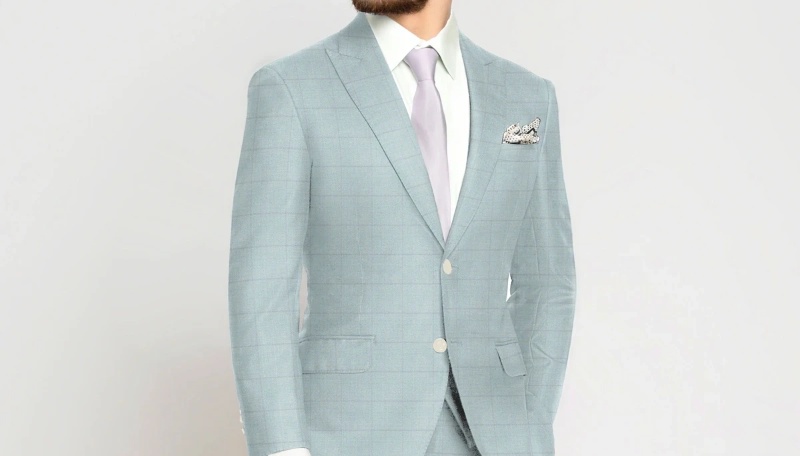
Patterned ties
Patterned ties like stripes, dots or paisley are an excellent way to elevate a blue suit, adding a touch of personality and creativity to your ensemble. Whichever pattern you choose, these ties can introduce visual interest and texture without overwhelming the overall look. However, the key to pulling off patterned ties with a blue suit lies in balancing color, scale, and occasion.
Opting for a patterned tie is a great way to inject energy into a simple outfit, especially if your suit is a solid color like navy or light blue. A patterned tie adds complexity, helping to avoid a monotonous look while still maintaining a sophisticated appearance. For more formal settings or when you want a more refined look, stick to subtle patterns like thin stripes or small polka dots. On the other hand, for less formal events or casual meetings, larger patterns like paisley or bold stripes can bring a more relaxed yet fashionable vibe.
When selecting a patterned tie, the most important thing is ensuring the colors don’t clash with your blue suit. For example, pairing a blue suit with a tie that has tones of red, gold, or even shades of green can create a harmonious contrast. Stick to color schemes that complement the blue, it’s best to avoid using too many competing bold colors. If the tie has multiple colors, ensure that one color is dominant, and the others act as accents, maintaining a balanced and coordinated look. Additionally, ensure the pattern isn’t too busy; a restrained pattern ensures your outfit remains stylish and doesn’t overwhelm the eyes.
The scale of the pattern and the size of the tie are also important to ensure a balanced and proportionate look. Smaller patterns like polka dots or fine stripes tend to work better with narrow ties, while larger patterns like paisley or bold stripes look better with wider ties. This is particularly relevant if you are wearing a slim or regular-fit suit. Make sure the tie’s proportions match the overall aesthetic. A well-chosen patterned tie not only complements your suit but also brings harmony to the overall outfit.
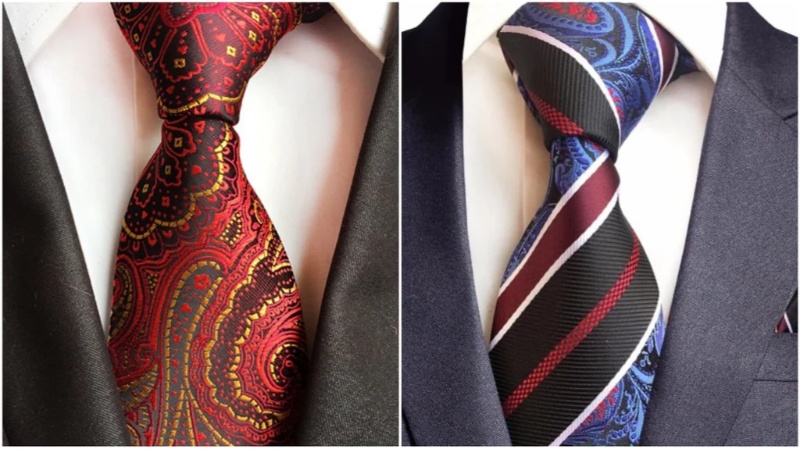
3. Matching blue suits with tie colors by occasion
Choosing the right tie color to pair with a blue suit is not just about looking stylish, but also about understanding the occasion and its specific dress code. A tie can significantly alter the tone of your outfit, transforming it from formal to casual or vice versa. Below, we’ll explore how to choose the perfect tie color for various occasions, ensuring you make the right impression every time.
What tie to wear with blue suit for a Wedding
For weddings, particularly formal ones, a blue suit is a classic and elegant choice. The tie you select should complement the celebratory nature of the event while maintaining a refined look. For a formal wedding, a silk tie in deep shades like navy, burgundy, or a rich wine color works wonderfully, creating a sophisticated and polished appearance. If the wedding has a lighter or more relaxed vibe, pastel colors such as light pink, soft lavender, or even a pastel blue tie can enhance the lighthearted, joyful atmosphere.
For grooms, opting for a tie that complements the wedding theme or even the bride’s dress can add a personal touch. A paisley or subtle patterned tie can also work, providing texture and interest while keeping the look formal and appropriate.

Best tie color for a blue suit in Business settings
In business environments, a blue suit paired with a well-chosen tie can create a look that is both authoritative and approachable. For most business settings, solid ties in classic shades like navy, burgundy, or dark grey are the safest and most professional choices. These colors communicate trust, confidence, and maturity. If you want to add a bit of personality while still looking professional, consider a tie with a subtle pattern, such as stripes or a small geometric print. Avoid overly bold colors like bright red or neon shades, as they can be distracting and may not convey the right message in a corporate setting.
For high-level meetings, a silk tie in a solid, muted color is ideal, while client-facing or business networking events might allow for slightly more creativity with patterned ties or lighter tones.
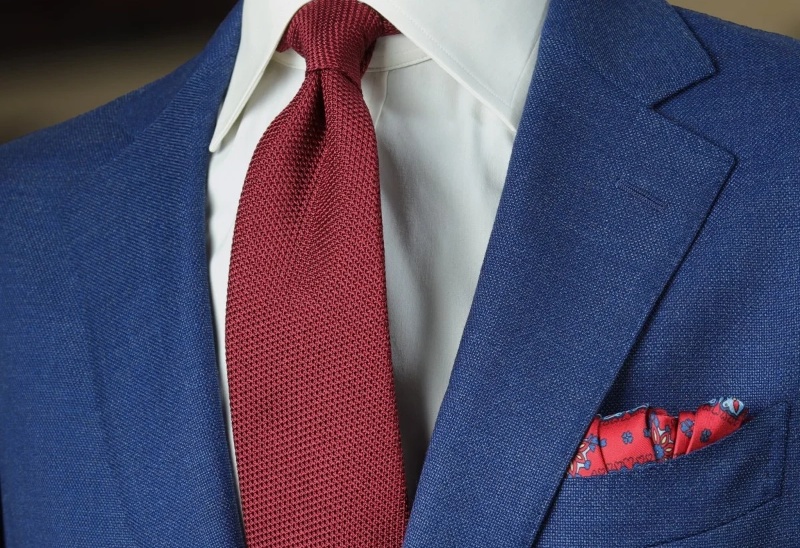
Tie ideas for Casual or smart-casual events
For more casual or smart-casual events, you have a bit more freedom in experimenting with tie colors and styles. A blue suit can easily be dressed down with a lighter tie in playful or relaxed colors. Consider wearing a tie in shades like soft pink, light green, or even pastel yellow for a fresh and vibrant look. Patterns such as polka dots, stripes, or even fun prints can add character to the outfit without appearing too formal.
If the event leans towards smart-casual, you can also experiment with textured ties, such as knitted or linen, to add a more laid-back and approachable vibe. These types of ties bring a modern edge to your blue suit, perfect for gatherings like brunches, casual parties, or daytime events where you want to look polished but relaxed.
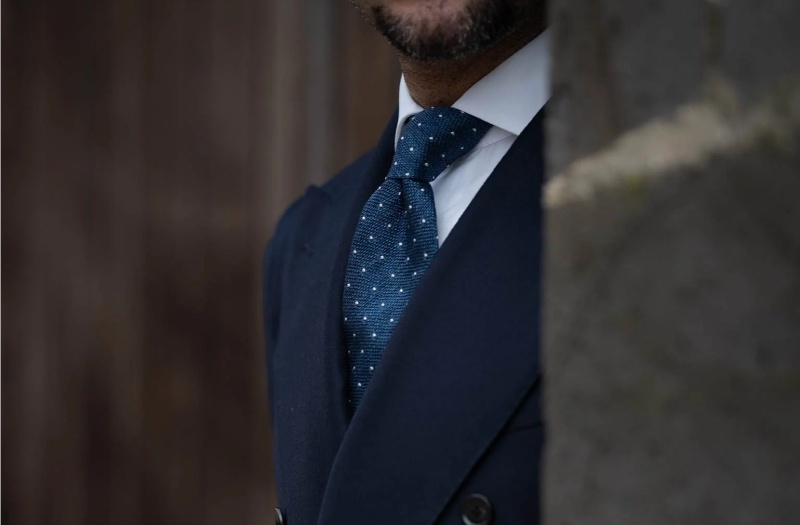
4. Common mistakes to avoid when pairing ties with blue suits
While pairing a tie with a blue suit seems like a straightforward task, there are several common mistakes that many people make. To help you achieve a polished and sophisticated look, here are some key errors to avoid when selecting your tie.
Choosing a tie that overpowers the suit
One of the biggest mistakes is selecting a tie that is too bold or loud, which can easily overshadow the elegance of the blue suit. While it’s important for your tie to stand out, it should never dominate the outfit. Bright neon colors, extremely large patterns, or flashy textures can distract from the overall look. Instead, aim for a tie that complements your suit without competing for attention. Muted tones, subtle patterns, and textures that blend harmoniously with your blue suit will create a balanced, cohesive look.
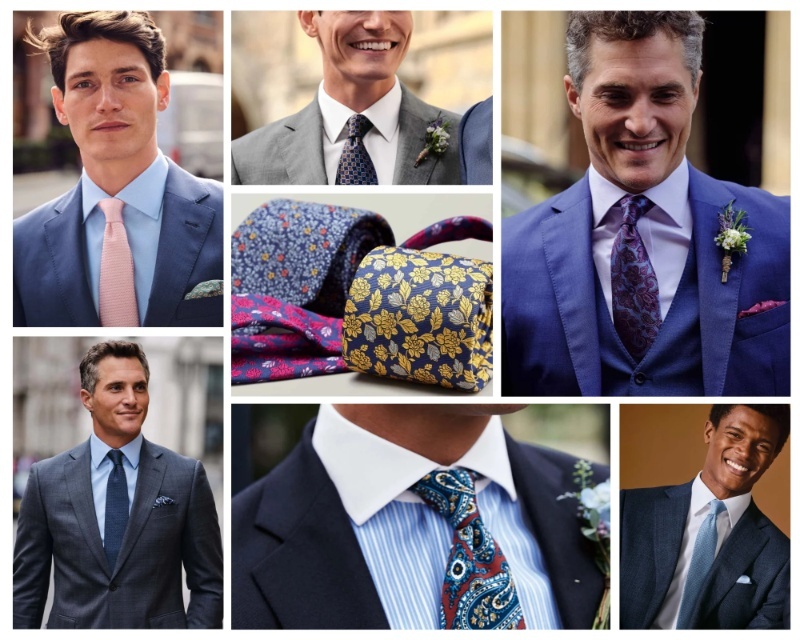
Mismatching tie and shirt colors
Another common mistake is pairing a tie with a shirt that clashes with the blue suit or creates a jarring visual contrast. For instance, pairing a deep blue tie with a light blue shirt may create a monochromatic look that lacks depth. On the other hand, wearing a bright red tie with a pale pink shirt could result in an overly busy appearance. To avoid this, select shirts in neutral tones like white, light grey, or pale blue, which will allow the tie to pop without overwhelming the outfit. If you choose a patterned tie, ensure that the pattern doesn’t clash with the shirt’s design.

Ignoring the occasion or dress code
The tie you choose should always align with the formality of the occasion. A mistake many make is wearing a tie that’s too casual for a formal setting or too formal for a laid-back event. For example, wearing a bright floral tie with a blue suit to a business meeting might be seen as inappropriate or distracting. Always consider the dress code before choosing your tie. For business settings, solid colors or subtle patterns work best, while weddings or casual outings might offer more freedom for experimenting with patterns and brighter hues.
Overdoing the pattern mixing
While patterned ties can add style and character to your look, mixing too many patterns can create a chaotic and disorganized appearance. Pairing a bold striped tie with a polka-dot shirt, for instance, can be visually overwhelming. Instead, aim for a simple, harmonious pairing where either the tie or the shirt has a pattern, but not both. If your tie has a pattern, opt for a solid shirt to let the tie shine. If you wear a patterned shirt, choose a more subdued, solid-colored tie to balance the look.

Choosing the wrong tie width
The width of your tie should complement the fit and cut of your suit. A common mistake is wearing a tie that’s too wide or too narrow for your suit. A slim, modern-fit suit pairs best with a narrower tie, while a classic, regular-fit suit can work well with a wider tie. The key is to maintain balance between the tie width and the suit’s proportions to avoid looking out of place.
FAQs about wearing ties with blue suits
Can you wear a black tie with a blue suit?
Yes, you can wear a black tie with a blue suit—especially in formal or evening settings. The combination creates a clean, sharp contrast that feels sleek and modern, particularly when paired with a crisp white dress shirt. However, keep in mind that a black tie typically gives off a more conservative or serious vibe. It’s ideal for formal dinners, evening weddings, or business events where you want to look refined without taking fashion risks. For daytime or more vibrant occasions, consider softer or more colorful alternatives to bring more life to the ensemble.
What tie goes with a navy blue suit and white shirt?
A navy blue suit and white shirt offer one of the most versatile foundations for tie pairing. You can go classic with a burgundy or deep red tie for a timeless, confident look. Want something a bit more modern? Try a dusty pink or muted gold tie to add color without being too loud. For business, deep forest green or charcoal gray adds understated elegance. And for weddings or celebratory events, a tie with a subtle pattern or texture in soft blues, purples, or even floral prints can elevate your look while maintaining a sophisticated tone.
What color pocket square matches best?
Your pocket square doesn’t need to match your tie exactly—in fact, it shouldn’t. Instead, it should complement the overall color palette. With a blue suit, white pocket squares are the safest and most classic option, offering timeless elegance and working with virtually any tie color. If you want to add a touch of personality, pick a pocket square that echoes a secondary color in your tie or shirt. For example, if you’re wearing a burgundy tie, a pocket square with hints of burgundy, cream, or even soft blue can pull the whole look together. The key is harmony, not exact repetition.
Whether you opt for a classic navy-on-navy look, a bold burgundy statement, or a soft pastel tone for a summer event, your tie is the finishing touch that brings the entire outfit together. By understanding color harmony and the context of the occasion, you’ll not only look sharp, you’ll feel it too. So next time you slip into your favorite blue suit, remember: the perfect tie isn’t just an accessor, it’s your signature.
Image cre: Internet
Create from my passion about sartorial that I accidently discover when I was searching to upgrade my style, this website is dedicated to providing in-depth knowledge, expert styling tips and the latest trends in men’s tailored fashion. Though sometimes I might sound a little cheesy cuz of all that philosophy book I’ve read 🙂
